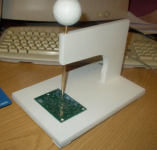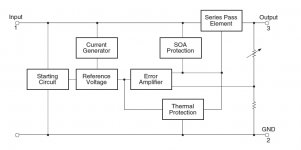I agree with that agreement, unless a person has something similar to those automatic glue placement machines. They are fun to watch in action though.Agree, glue is much more trouble than it's worth.
I thought this was a nifty diy build. It's sort of a third hand for SMT:
Attachments
I tin one pad (if one side is to a ground plane, that's the first side to solder), then slide the component on, solder the pre-tinned pad, then solder the other pad(s) then reflow each joint just to check for no dry joints.
Reflow process with solder paste will rely on surface tension of the solder to pull the component straight, which is a neat trick IMO Though there is risk that a bridge can be created between applying solder paste and placing in the oven if the board is bumped. Still need to check for all of the usual things when using a reflow oven, there is no free lunch.
Though there is risk that a bridge can be created between applying solder paste and placing in the oven if the board is bumped. Still need to check for all of the usual things when using a reflow oven, there is no free lunch.
Reflow process with solder paste will rely on surface tension of the solder to pull the component straight, which is a neat trick IMO
I talk to Jan Didden yesterday.
To make it short the SMD version of the regulator will be described in an article in detail in Linear Audio Vol.7.
As usual Jan is very generous, so you may even get a pair of free PCBs with the book.
Until then we'll probably post some interrim results to keep you informed of progress.
Patrick
To make it short the SMD version of the regulator will be described in an article in detail in Linear Audio Vol.7.
As usual Jan is very generous, so you may even get a pair of free PCBs with the book.
Until then we'll probably post some interrim results to keep you informed of progress.
Patrick
Looks like a great concept, though the one in your photo appears to have a base made from some kind of plastic or other ESD non-approved material.. . . I thought this was a nifty diy build. It's sort of a third hand for SMT:
Dale
I have a question about the Jung/Didden REgulators. Are the seperate grounds necessary? Does a shared ground prevent hte use of sense/shunt capabililty. Any suggested reading on the topic.
Read the article series from 1995 on Walt's website. My part, part III, addresses the reasons and details for the remote sense.
BTW here's another neat SMD aid: http://www.frantone.com/designwritings/design_writings.html#hold
jan
THanks again. Answered all my questions. Very well written.
There IS a reason why I started Linear Audio
jan
Comments to Vol 5 articles
I have received several letters commenting on articles in Linear Audio Vol 5.
Just finished putting them all on-line in the letters section.
There are comments to the articles by Hans van Maanen, Morgan Jones, Gary Galo, Bruno Putzeys and Richard Burwen. All are PDF and available for download.
jan
I have received several letters commenting on articles in Linear Audio Vol 5.
Just finished putting them all on-line in the letters section.
There are comments to the articles by Hans van Maanen, Morgan Jones, Gary Galo, Bruno Putzeys and Richard Burwen. All are PDF and available for download.
jan
The ones shown in post #677 are 5-pin with both output sense and Gnd sense.
Jumper pads are provided on board to convert them to 3-pin if so wish.
I like them ~ TO220 size as they are then very handy as 78xx / 79xx replacements.
Patrick
Hello,
Not so sure at least for digital applications. 7805 and there higher voltage versions probably have superior performance in the 1mhz+ region or 1-3mhz region to the super-regs.
I am sure Walt Jung said something to this affect himself. Op amps like the AD797 etc trade H.F. loop gain at the expense of getting enormous L.F. loop gain./PSRR/Zout etc. Great for LF apps but not digital.
I doubt, due to the way the 7805, 7815, 7915 where designed, that the superreg's of any derision can actually beat them at least for digital applications on some measurements.
Best Regards
Kevin
Last edited:
Those 78xx and 79xx are not conceptually different then a superreg: a reference, a series device, and an error amp. Only much less in performance than a superreg. If you compare the data sheet for the 78xx, 79xx to the superreg measurements, you'll see there's really no competition.
Don't let the huge DC gain of the opamps put you on the wrong foot. Yes, the 797 gain at DC is huge, but it's gain is huge at all frequencies compared to the 78, 79 opamps.
jan
Don't let the huge DC gain of the opamps put you on the wrong foot. Yes, the 797 gain at DC is huge, but it's gain is huge at all frequencies compared to the 78, 79 opamps.
jan
Those 78xx and 79xx are not conceptually different then a superreg: a reference, a series device, and an error amp. Only much less in performance than a superreg. If you compare the data sheet for the 78xx, 79xx to the superreg measurements, you'll see there's really no competition.
Don't let the huge DC gain of the opamps put you on the wrong foot. Yes, the 797 gain at DC is huge, but it's gain is huge at all frequencies compared to the 78, 79 opamps.
jan
Hello Jan,
This was always the problem with the datasheets for the 78/79** critters- it is not spec'd in the upper Mhz region where it matters for digital.
WaltJ suggested using a LCR filter (great idea) in one of his articles for the super-reg, that could add maybe 70db of additional d.c. line rejection at 1 mhz+. Absolutely no problems with that.
But the jury is still out on whether the super-regs can beat plain-vanilla 78** or 79** type regulators for digital apps _without_ external help whether passive or active.
Kevin
PS. It is accurate measurements that matter here not talk etc.
But the jury is still out on whether the super-regs can beat plain-vanilla 78** or 79** type regulators for digital apps _without_ external help whether passive or active.
Kevin
So, show me measurements that show the 7805 as good as Walts' 5V version.
You said 'the way the 78xx is designed' - apparently not realising they are conceptually the same as a superreg.
A reference, an error amp receiving both the ref and a sample of Vout, driving a series pass element.
Of course, the superreg is using optimized and high-quality parts in all places, and that poor 78xx can't, so it is no shame for it to be rather limited in line rejection, noise, Zout, load rejection, what have you.
jan
Attachments
Last edited:
- Home
- General Interest
- Everything Else
- New Linear Audio publication!

